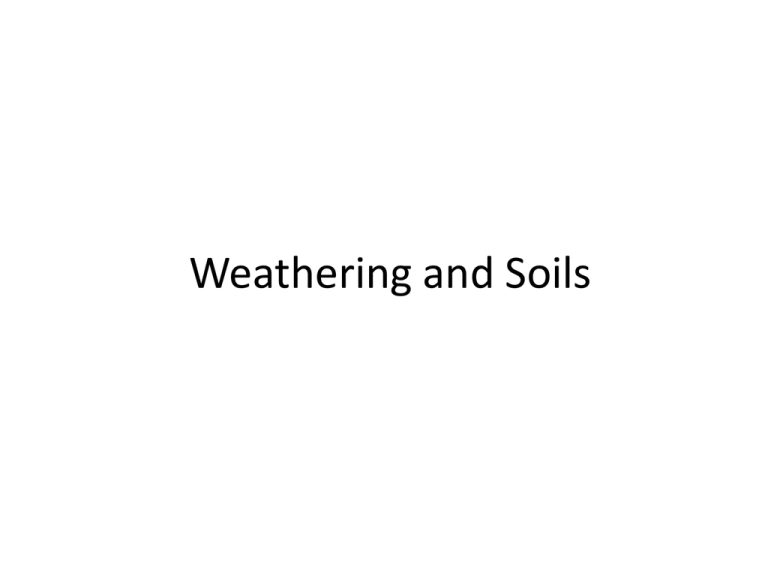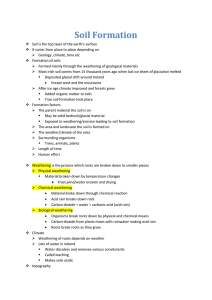Weathering and Soils
advertisement

Weathering and Soils Weathering Breakdown of Rock near the Surface Due to Surface Processes Chemical Alteration • Solution & Leaching • Biological Action • Hydration Mechanical • Impact • Wedging: Frost, Plant Roots, Salt Crystal Growth, Expansion of Hydrated Minerals Salt Crystallization, Utah Never Safe From Weathering Weathering Rates Differential Weathering and Erosion Differential Weathering and Erosion Surface Area and Weathering Surface-Volume Effects Spheroidal Weathering Spheroidal Weathering and Exfoliation Spheroidal Weathering Joints and Spheroidal Weathering Cavernous Weathering What Determines Soil Type • • • • • Climate Vegetation Drainage Time Parent Material – Residual - Transported – Least Important Factor for Mature Soils Soil Formation Processes Leaching from Surface • K, Mg, Na • Ca • Si • Al, Fe Accumulation beneath Surface • Al, Fe in Humid Climates • Ca in Arid Climates Soil Horizons and Profiles Soil Horizons • Layers in Soil • Not Deposited, but Zones of Chemical Action Soil Profile • Suite of Layers at a Given Locality Principal Soil Horizons • O - Organic (Humus) Often Absent • A – Leaching – K, Mg, Na, Clay Removed • E - Bleached Zone - Present Only in Certain Soils • B – Accumulation – Absent in Young Soils – Distinct in Old Soils – Al, Fe, Clay (Moist) – Si, Ca (Arid) • C - Parent Material Limits of Soil Formation Balance Between: • Downward Lowering of Surface • Downward Migration of Horizons If erosion rapid or soil evolution slow, soils may never mature beyond a certain point. Extremely ancient soils may have lost everything movable Soil Classification This may be the most difficult classification problem in science because of the many factors involved. Varied Bases for Classification • Parent Material • Special Constituent Materials • Maturity • Structure • Climate & Vegetation Multiple Objectives • Scientific – Genesis & Evolution • Agricultural – Fertility – Most Effective Use • Engineering – Slope Stability – Expansion and Shrinkage – Stability of Excavations "The 7th Approximation" • U.S. Soil Conservation Service • 12 Soil Orders "The 7th Approximation" Degree of Weathering and B Horizon Development Little Slight Moderate Large Extreme Entisols Aridisols Inceptisols Alfisols Spodosols Ultisols Mollisols Oxisols Soils Defined by Special Constituent Materials Andisols Volcanic Ash Histosols Peat, Organic Matter Vertisols “Self-Mixing” Clay Soils Gelisols Soils on Permafrost Soils of the U.S. Typical Soil Profile (Spodosol) Aridisol, Kuwait Ultisols: Alabama Tennessee Kaolinite, Georgia Oxisol, California (a Paleosol) No O Horizon Paleosol, Scotland Loess • • • • Silt-sized Derived from Glacial Outwash in U.S. Found in U.S., E. Europe, China Parent material of world’s prime agricultural soils – – – – – Available nutrients Fine size – lots of surface area Cohesive – good root support Porous – retains water well No Rocks!!!! Windblown silt is called loess Loess, Wisconsin Loess in the U.S. Loess is the raw material for many mollisols, the best agricultural soils Loess in Europe Loess is the raw material for many mollisols, the best agricultural soils Loess in China Loess is the raw material for many mollisols, the best agricultural soils Impacts of Soil Loss • Lessened agricultural productivity • Respiratory hazards (wind erosion) • Siltation of streams – Wetland loss – Destruction of fish habitat – Obstruction of navigation • Eutrophication • Chemical pollution Controlling Soil Loss • • • • • • Windrows Retain vegetation cover Contour plowing Strip cropping No-till agriculture Sediment dams Strip Cropping and Contour Plowing Strip Cropping and Contour Plowing






